3. Backlot Stunt Coaster
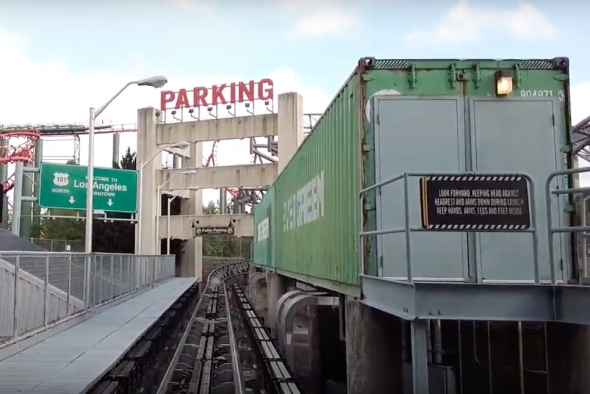
Location: Kings Island, Kings Dominion, and Canada’s Wonderland
Opened: 2005 and 2006
Opened first in 2005 at Kings Island when Paramount was at the helm, the Backlot Stunt Coaster (then called Italian Job: Stunt Track) fused Paramount’s intellectual property with a surprising product: a launched coaster for families. The result is a brief ride that doesn’t stand under scrutiny after a long wait, but one packed with personality (and unexpected punch) that’s perfect for families to ride together.

On board ¾ scale MINI Coopers (complete with functioning doors, windows, and on-board audio), guests were launched into an upward triple helix (cleverly set in a parking garage shell – up-and-around, just like in a parking deck) before slaloming through police cars, rumbling through an overbanked turn, whipping down a staircase, and then coming to a halt in an industrial yard. There, a rising helicopter would fire rounds, causing gas canisters to spray riders before igniting flame effects. In a second surprise launch, the cars would race into the sewers before emerging from a billboard and splashing down in an aqueduct.
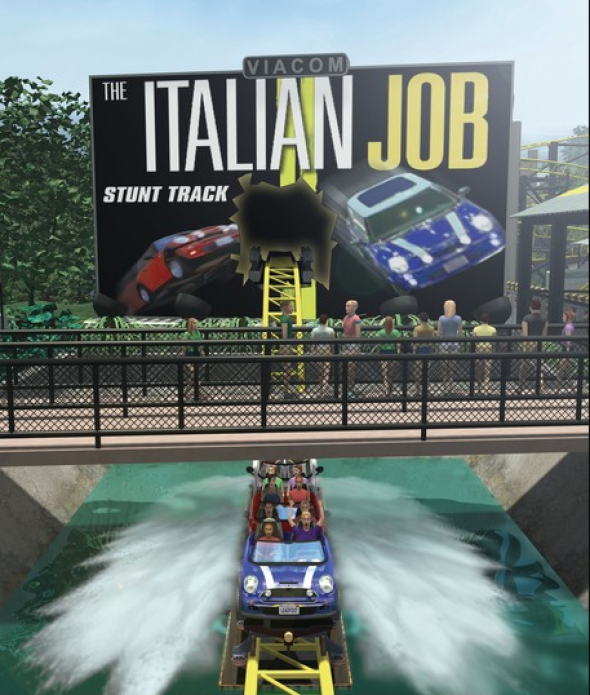
Though the ride technically recreated the major scenes of The Italian Job’s action packed finale, the story was a bit more convoluted if only because (in typical “studio” park fashion) riders weren’t cast as escaping thieves, but as stunt car drivers filming the big finale themselves. Though we often deride the “stuntman” role as the mark of a bad story, it worked for this ride and felt right in the Paramount Parks – a good balance of theming and thrills for seasonal, regional parks!
Given that two of the three installation have essentially had their special effects shut off, it’s clear that Cedar Fair isn’t interested in these kinds of zippy, well-themed rides packed with “extras”… But even if the Backlot Stunt Coasters were “cheap and cheerful” additions at the end of Paramount’s reign, they’re evidence of what a critical role this kind of ride can play in making a park more than just a thrill park.
4. Space Mountain: De la Terre a la Lune
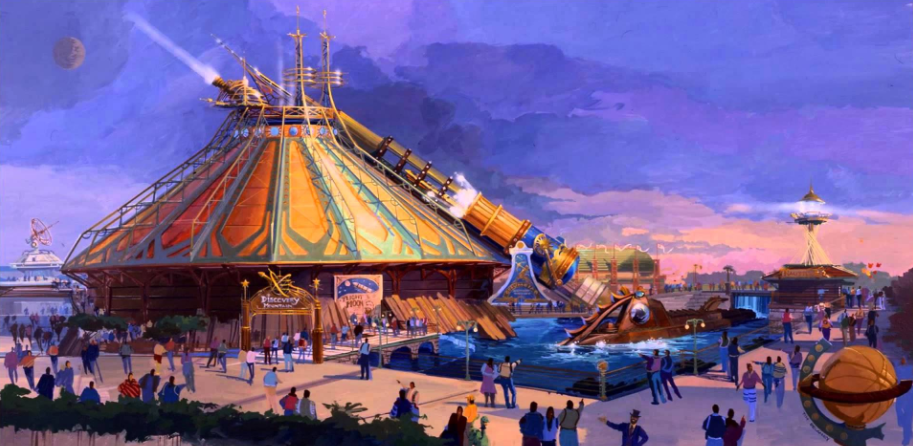
Location: Disneyland Paris
Opened: 1995
Though Space Mountain has been a mainstay of Disney Parks since the first opened at Magic Kingdom in 1975, the ride is not what we’d call a story coaster. Instead, it’s meant to embody the exhilaration of free flight, the wonder of space, and the feeling of the unknown – something that would probably place it in our “theme coaster” category. But by time Disneyland Paris opened in the ‘90s, the Space Age was long over, and a stark, white, “NASA” inspired Space Mountain wouldn’t exactly resonate with French audiences.
Designers smartly returned Tomorrowland to the past, creating the incredible Discoveryland in its place – a retrofuturistic golden land of the future as envisioned by Jules Verne’s Voyages Extraordinaires and his contemporaries. In 1995, the land gained its iconic anchor and Lost Legend: Space Mountain – De la Terre a la Lune, based on the 19th century novel by Verne. The towering bronze and copper peak is easily identified by the massive, golden Columbiad Cannon that rests along its sloped exterior with an aim set for the stars.

After queuing in the Baltimore Gun Club and observing blueprints of the Cannon, guests would board their trains and be loaded into the Cannon’s core. With an inclined launch from the cannon (including recoil and smoke), guests would be propelled into the mountain from its top, racing through set pieces inspired by the book and Georges Méliès silent film adaptation.
As the first Disney coaster with synchronized on-board audio, the whole journey was underscored by a masterful orchestral track. After breaking back through Earth’s atmosphere in a hypnotic light show, the brake run signaled guests’ return from their trip to the moon, passing through the Electro-de-Velocitor.

In 2005, the ride was re-named Space Mountain: Mission 2, losing its retro-accents and instead taking on the same sci-fi styling as its American counterparts. In 2017, Mission 2 was retired in favor of a permanent switch to Star Wars Hyperspace Mountain: Rebel Mission. Though both are arguably story coasters, neither can manage to explain why guests are being launched from a gold cannon or why the story begins and ends in a 19th century retro-futuristic literary port of discovery.
5. Harry Potter and the Escape from Gringotts
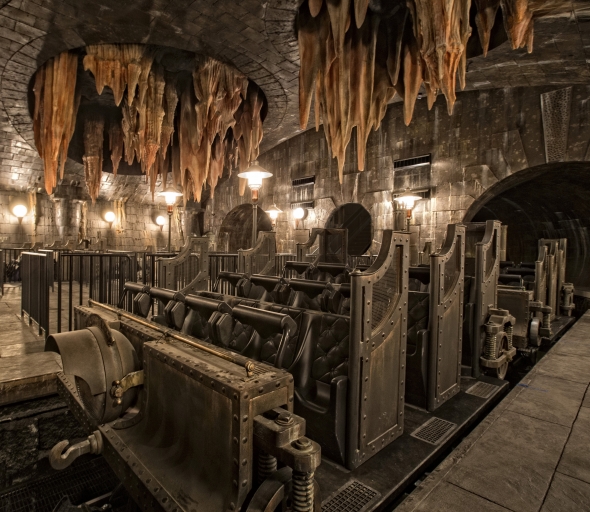
Location: Universal Studios Florida
Opened: 2014
After the runaway success of the Wizarding World of Harry Potter and its snowy Hogwarts at Universal’s Islands of Adventure, an expansion of the land was all but assured. In 2014, Diagon Alley opened at Universal Studios Florida, with the Hogwarts Express cleverly connecting the two Wizarding World lands between parks. Naturally, the land’s E-Ticket is a journey through the palatial Gringotts Wizarding Bank and the bottomless subterranean vaults beneath connected by magical mine carts. (It’s as if J.K. Rowling had a theme park in mind when she wrote the stories!)
Given that the first Potter E-Ticket, Forbidden Journey, introduced a complex, hard-to-describe, and never-before-seen ride system, expectations were high for Gringotts, too. And the ride is astounding, essentially combining a roller coaster with the setup first used by the Modern Marvel: The Amazing Adventures of Spider-Man (and somewhat overused since…). Though some fans were disappointed by Gringotts’ relative lack of industry-changing thrills, the ride is a storytelling master class.
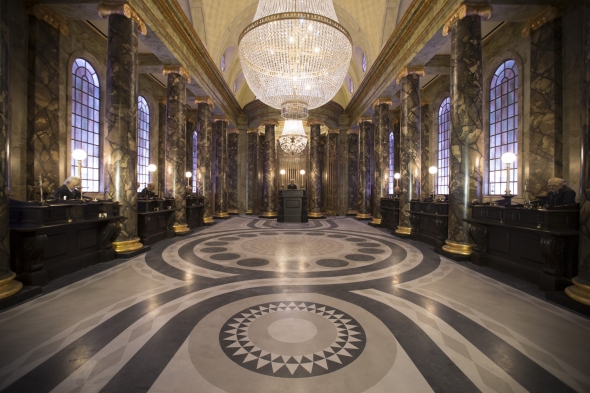
Especially since Forbidden Journey feels like a breathless race through the Wizarding World’s biggest settings and villains with no real sense of place or plot, it’s respectable that Gringotts’ story feels immensely grounded. The set-up is that we’ve arrived to open an account at Gringotts at a most inopportune time: unbeknownst to us, Harry, Ron, and Hermione’s bank heist (as seen in the Deathly Hallows film) is happening at the same time as they search for Voldemort’s Horcrux in Bellatrix Lestrange’s vault.
This provides a unique set-up where the ride path occasionally intersects with the trio in “real time,” giving us a new perspective of the events we saw in the film. While the “coaster” elements are brief (essentially bookmarking the experience), it’s still a definite evolution of using coasters as a storytelling medium.
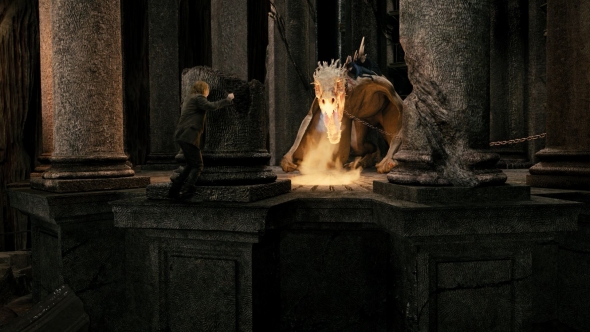
In that way, Gringotts isn’t just a spectacular “story coaster;” it’s a clever reinvention of the oft-derided “book report ride.” Yes, it’s an event or story we already know… but it’s presented from a (literal) new point-of-view, giving riders the chance to have their own adventure.


